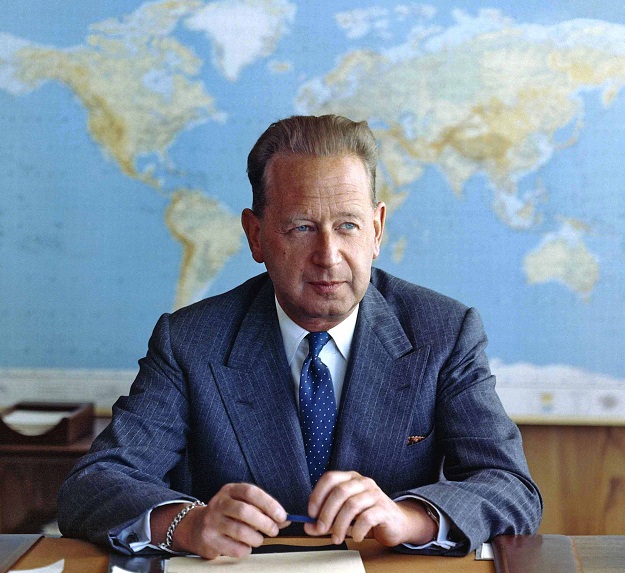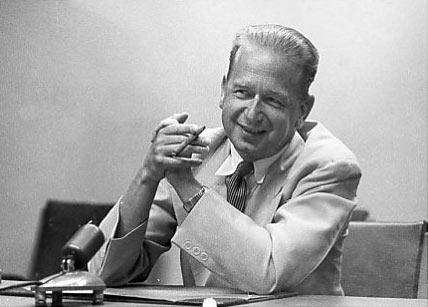<Back to Index>
- 2nd Secretary General of the United Nations Dag Hjalmar Agne Carl Hammarskjöld, 1905
PAGE SPONSOR
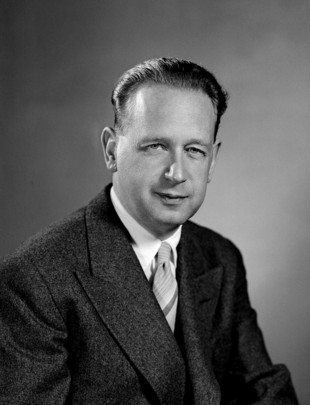
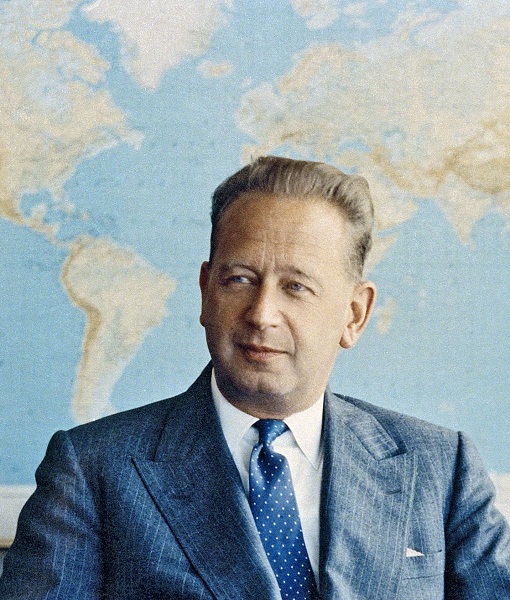
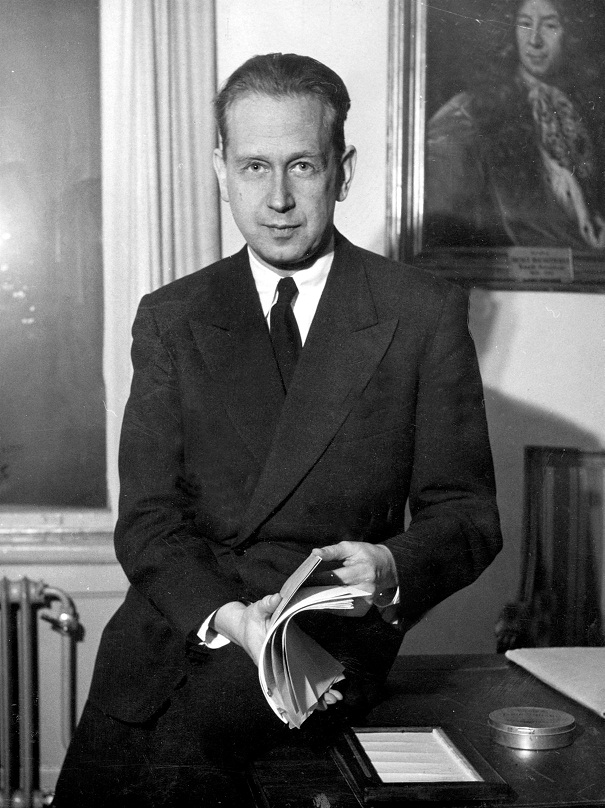
Dag Hjalmar Agne Carl Hammarskjöld (29 July 1905 – 18 September 1961) was a Swedish diplomat, economist and author. The second Secretary General of the United Nations, he served from April 1953 until his death in a plane crash in September 1961. He is the only person to have been awarded a posthumous Nobel Peace Prize. Hammarskjöld remains the only U.N. Secretary General to die in office, and his death occurred en route to ceasefire negotiations. American President John F. Kennedy called Hammarskjöld “the greatest statesman of our century".
Dag Hammarskjöld was born in Jönköping, Sweden, but spent most of his childhood in Uppsala. The fourth and youngest son of Hjalmar Hammarskjöld, Prime Minister of Sweden from 1914 to 1917, and Agnes Hammarskjöld (née Almquist), Hammarskjöld's ancestors served the Monarchy of Sweden since the 17th century. He studied first at Katedralskolan and then at Uppsala University where he graduated with a Bachelor of Laws and a Master's degree in Political economy. During this time he served for a year as the first Curator at Uplands Nation later moving to Stockholm.
From 1930 to 1934, Hammarskjöld was a Secretary on a governmental committee on unemployment. During this time he wrote his economics thesis, "Konjunkturspridningen" ("The Spread of the Business Cycle"), and received a doctorate from Stockholm University. In 1936, he became a Secretary at the Sveriges Riksbank and was soon promoted. From 1941 to 1948, he served as Chairman of the bank.
During this time Hammarskjöld also held political positions. Early in 1945, he was appointed an adviser to the cabinet on financial and economic problems. He helped coordinate government plans to alleviate the economic problems of the post war period. In 1947, Hammarskjöld was appointed to a position with Sweden’s Ministry for Foreign Affairs, and in 1949 he became the State Secretary for Foreign Affairs. A delegate to the Paris conference that established the Marshall Plan, in 1948 he was again in Paris to attend a conference for the Organisation for European Economic Co-operation. In 1950, he became head of the Swedish delegation to UNISCAN. In 1951, he became a cabinet Minister without Portfolio. Although Hammarskjöld served in a cabinet dominated by the Social Democrats, he never officially joined any political party. In 1951, Hammarskjöld became Vice Chairman of the Swedish delegation to the United Nations General Assembly in Paris. He became the Chairman of the Swedish delegation to the General Assembly in New York in 1952. On 20 December 1954, he was elected to take his father's vacated seat in the Swedish Academy.
When Trygve Lie resigned from his post as UN Secretary General in 1953, the United Nations Security Council recommended Hammarskjöld for the post. It came as a surprise to him. Seen as a competent technocrat without political views, he was selected on 31 March by a majority of 10 out of eleven Security Council members. The UN General Assembly elected him in the 7–10 April session by 57 votes out of 60. In 1957, he was reelected.
Hammarskjöld began his term by establishing his own secretariat of 4,000 administrators and setting up regulations that defined their responsibilities. He was also actively engaged in smaller projects relating to the UN working environment. For example, he planned and supervised in every detail the creation of a "meditation room" in the UN headquarters. This is a place dedicated to silence where people can withdraw into themselves, regardless of their faith, creed or religion.
During his term, Hammarskjöld tried to smooth relations between Israel and the Arab states. Other highlights include a 1955 visit to China to negotiate release of 15 captured U.S. pilots who had served in the Korean War, the 1956 establishment of the United Nations Emergency Force, and his intervention in the 1956 Suez Crisis. He is given credit by some historians for allowing participation of the Holy See within the United Nations that year.
In 1960, the former Belgian Congo and then newly independent Congo asked for UN aid in defusing the Congo Crisis. Hammarskjöld made four trips to the Congo. His efforts towards the decolonization of Africa were considered insufficient by the Soviet Union; in September 1960, the Soviet government denounced his decision to send a UN emergency force to keep the peace. They demanded his resignation and the replacement of the office of Secretary - General by a three - man directorate with a built - in veto, the "troika". The objective was to, citing the memoirs of Soviet leader Nikita Khrushchev, “equally represent interests of three groups of countries: capitalist, socialist and recently independent.” Hammarskjöld denied Patrice Lumumba's request to help force the Katanga Province to rejoin the Congo despite being good friends, since Dag saw the UN as a neutral force meant to avoid human rights violations in conflict areas and looked to diplomacy as a solution rather than military action. Lumumba then turned to the United States, but on landing in the U.S. he was ignored and not received formally by President Eisenhower who hated him believing him to be a communist and thus a threat to U.S. interests in the Congo region. This resulted in a desperate, fearful and worried Lumumba, now branded a communist to turn to the Soviets for help, as the best way available to him to safeguard the future of his Country.
In September 1961, Hammarskjöld learned about fighting between "non combatant" UN forces and Katangese troops of Moise Tshombe. He was en route to negotiate a ceasefire on 18 September when his Douglas DC-6 airliner SE-BDY crashed near Ndola, Northern Rhodesia (now Zambia). Hammarskjöld and fifteen others perished in the crash.
A special report issued by the United Nations following the crash stated that a bright flash in the sky was seen at approximately 1:00. According to the UN special report, it was this information that resulted in the initiation of search and rescue operations. Initial indications that the crash might not have been an accident led to multiple official inquiries and persistent speculation that the Secretary General was assassinated.
Hammarskjöld's death was a memorable event. The Dag Hammarskjöld Crash Site Memorial is under consideration for inclusion as a UNESCO World Heritage Site. A press release issued by the Prime Minister of the Republic of the Congo stated that, "... in order to pay a tribute to this great man, now vanished from the scene, and to his colleagues, all of whom have fallen victim to the shameless intrigues of the great financial Powers of the West... the Government has decided to proclaim Tuesday, 19 September 1961, a day of national mourning."
Following the death of Hammarskjöld, there were three inquiries into the circumstances that led to the crash: the Rhodesian Board of Investigation, the Rhodesian Commission of Inquiry, and the United Nations Commission of Investigation.
The Rhodesian Board of Investigation looked into the matter between 19 September 1961 and 2 November 1961 under the command of British Lt. Colonel M.C.B. Barber. The Rhodesian Commission of Inquiry held hearings from 16–29 January 1962 without United Nations oversight. The subsequent United Nations Commission of Investigation held a series of hearings in 1962 and in part depended upon the testimony from the previous Rhodesian inquiries. Five "eminent persons" were assigned by the new Secretary General to the UN Commission. The members of the commission unanimously elected Nepalese diplomat Rishikesh Shaha to head an inquiry.
The three official inquiries failed to determine conclusively the cause of the crash that led to the death of Hammarskjöld. The Rhodesian Board of Investigation sent 180 men to search a six square kilometer area of the last sector of the aircraft's flight path, looking for evidence as to the cause of the crash. No evidence of a bomb, surface - to - air missile, or hijacking was found. The official report stated that two of the dead Swedish bodyguards had suffered multiple bullet wounds. Medical examination, performed by the initial Rhodesian Board of Investigation and reported in the UN official report, indicated that the wounds were superficial, and that the bullets showed no signs of rifling. They concluded that the bullets exploded in the fire in close proximity to the bodyguards. No other evidence of foul play was found in the wreckage of the aircraft.
Previous accounts of a bright flash in the sky were dismissed as occurring too late in the evening to have caused the crash. The UN report speculated that these flashes may have been caused by secondary explosions after the crash. The sole survivor, Sergeant Harold Julien, indicated that there was a series of explosions that preceded the crash. The official inquiry found that the statements of witnesses who talked with Julien before he died in hospital five days after the crash were inconsistent.
The report states that there were numerous delays that violated the established search and rescue procedures. There were three separate delays: the first delayed the initial alarm of a possible plane in trouble; the second delayed the "distress" alarm, which indicates that communications with surrounding airports indicate that a missing plane has not landed elsewhere; the third delayed the eventual search and rescue operation and the discovery of the plane wreckage, just miles away. The medical examiners report was inconclusive; one report said that Hammarskjöld had died on impact; another stated that Hammarskjöld might have survived had rescue operations not been delayed. The report also said that the chances of Sgt. Julien surviving the crash would have been "infinitely" better if the rescue operations had been hastened.
Despite the multiple official inquiries that failed to find evidence of assassination, some continue to believe that the death of Hammarskjöld was not an accident.
At the time of Hammarskjöld's death, Western intelligence agencies were actively involved in the political situation in the Congo, which culminated in Belgian and United States support for the secession of Katanga and the assassination of former prime minister Patrice Lumumba. Belgium and the United Kingdom had a vested interest in maintaining their control over much of the country's copper industry during the Congolese transition from colonialism to independence. Concerns about the nationalization of the copper industry could have provided a financial incentive to remove either Lumumba or Hammarskjöld.
The involvement of British officers in commanding the initial inquiries, which provided much of the information about the condition of the plane and the examination of the bodies, has led some to suggest a conflict of interest. The official report dismissed a number of pieces of evidence that would have supported the view that Hammarskjöld was assassinated. Some of these dismissals have been controversial, such as the conclusion that bullet wounds could have been caused by bullets exploding in a fire. Expert tests have questioned this conclusion, arguing that exploding bullets could not break the surface of the skin. Major C. F. Westell, a ballistics authority, said, "I can certainly describe as sheer nonsense the statement that cartridges of machine guns or pistols detonated in a fire can penetrate a human body." He based his statement on a large scale experiment that had been done to determine if military fire brigades would be in danger working near munitions depots. Other Swedish experts conducted and filmed tests showing that bullets heated to the point of explosion nonetheless did not achieve sufficient velocity to penetrate their box container.
Sir Denis A H Wright, the then British ambassador to Ethiopia, in his annual report for 1961 establishes linkage of Hammarskjold’s death to British refusal to allow an Ethiopian military plane carrying troops destined to join the UN mission, landing at Entebbe and overflying British - controlled Uganda to the Congo. Their refusal was only lifted after the death of the Secretary General. A Foreign Office official noting his comments on file, wrote affirming no “skeletons” in British cupboard and suggesting the Ambassador's comments should be removed from the final, official ‘printed’ version of the annual report.
On 19 August 1998, Archbishop Desmond Tutu, chairman of South Africa's Truth and Reconciliation Commission (TRC), stated that recently uncovered letters had implicated the British MI5, the American CIA, and then South African intelligence services in the crash. One TRC letter said that a bomb in the aircraft's wheel bay was set to detonate when the wheels came down for a landing. Tutu said that they were unable to investigate the truth of the letters or the allegations that South Africa or Western intelligence agencies played a role in the crash. The British Foreign Office suggested that they may have been created as Soviet misinformation or disinformation.
On 29 July 2005, Norwegian Major General Bjørn Egge gave an interview to the newspaper Aftenposten on the events surrounding Hammarskjöld's death. According to General Egge, who had been the first UN officer to see the body, Hammarskjöld had a hole in his forehead, and this hole was subsequently airbrushed from photos taken of the body. It appeared to Egge that Hammarskjöld had been thrown from the plane, and grass and leaves in his hands might indicate that he survived the crash – and that he had tried to scramble away from the wreckage. Egge does not claim directly that the wound was a gunshot wound.
In his speech to the 64th session of the United Nations General Assembly on 23 September 2009, Colonel Gaddafi called upon the Libyan president of UNGA, Ali Treki, to institute a UN investigation into the assassinations of Congolese prime minister, Patrice Lumumba, who was overthrown in 1960 and murdered the following year, and of UN Secretary General Dag Hammarskjöld in 1961.
According to a dozen witnesses interviewed by Swedish aid worker Göran Björkdahl in the 2000s (decade), Hammarskjöld's plane was shot down by another aircraft. Björkdahl also reviewed previously unavailable archive documents and internal UN communications. He believes that there was an intentional shoot down for the benefit of mining companies like Union Minière. A U.S. intelligence officer who was stationed at an electronic surveillance station in Cyprus stated that he heard a cockpit recording from Ndola. In the cockpit recording a pilot talks of closing in on the DC6 in which Hammarskjold was traveling, guns are heard firing, and then the words "I've hit it".
- Hammarskjöld posthumously received the Nobel Peace Prize in 1961, having been nominated before his death.
- Honorary degrees: The Carleton University in Ottawa (then called Carleton College) awarded its first ever honorary degree to Hammarskjöld in 1954 when it presented him with a Legum Doctor, honoris causa. The University has continued this tradition by conferring an honorary doctorate upon every subsequent Secretary General of the United Nations. He also held honorary degrees from Oxford University, England; in the United States from Harvard, Yale, Princeton, Columbia, the University of Pennsylvania, Amherst, Johns Hopkins, the University of California, and Ohio University; in Sweden, Uppsala University; and in Canada from McGill University as well as Carleton.
- On April 6, 2011, the Bank of Sweden announced that Hammarskjöld's image will be used on the 1000 kronor banknote, the highest denomination banknote in Sweden.
In 1953, soon after his appointment as United Nations secretary general, Hammarskjöld was interviewed on radio by Edward R. Murrow. In this talk he declared: "But the explanation of how man should live a life of active social service in full harmony with himself as a member of the community of spirit, I found in the writings of those great medieval mystics [Meister Eckhart and Jan van Ruysbroek] for whom 'self - surrender' had been the way to self - realization, and who in 'singleness of mind' and 'inwardness' had found strength to say yes to every demand which the needs of their neighbors made them face, and to say yes also to every fate life had in store for them when they followed the call of duty as they understood it."
His only book, Vägmärken (Markings), was published in 1963. A collection of his diary reflections, the book starts in 1925, when he was 20 years old, and ends at his death in 1961. This diary was found in his New York house, after his death, along with an undated letter addressed to then Swedish Permanent Under - Secretary for Foreign Affairs, Leif Belfrage. In this letter, Dag writes, "These entries provide the only true 'profile' that can be drawn ... If you find them worth publishing, you have my permission to do so". The foreword is written by W.H. Auden, a friend of Dag's. Markings was described by a theologian, the late Henry P. Van Dusen, as "the noblest self - disclosure of spiritual struggle and triumph, perhaps the greatest testament of personal faith written ... in the heat of professional life and amidst the most exacting responsibilities for world peace and order." Hammarskjöld writes, for example, "We are not permitted to choose the frame of our destiny. But what we put into it is ours. He who wills adventure will experience it — according to the measure of his courage. He who wills sacrifice will be sacrificed — according to the measure of his purity of heart." Markings is characterized by Hammarskjöld's intermingling of prose and haiku poetry in a manner exemplified by the 17th century Japanese poet Basho in his Narrow Roads to the Deep North. In his foreword to Markings, the English poet W. H. Auden quotes Hammarskjöld as stating "In our age, the road to holiness necessarily passes through the world of action."
The Evangelical Lutheran Church in America commemorates the life of Hammarskjöld as a renewer of society on the anniversary of his death, September 18.
